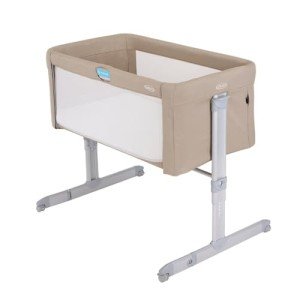The Comprehensive Guide To Bedside Cot For Co-Sleeping

The Benefits and Considerations of Bedside Cots for Co-Sleeping
Co-sleeping has actually become a popular choice for many new parents who look for to maintain close proximity to their infants throughout the night. Along with standard co-sleeping practices, bedside cots are getting traction as an option that offers both the convenience of nearness and the security of separate sleeping spaces. This short article aims to explore the concept of bedside cots for co-sleeping, highlighting their advantages, possible disadvantages, suggestions for selection, and common issues.
Comprehending Bedside Cots
Bedside cots, also referred to as side-sleepers or co-sleepers, are specially created cribs that are attached to the side of the parents' bed. They enable parents to maintain easy access to their infants at night while providing a different sleeping area that can improve safety and comfort.
Features of Bedside Cots
- Size and Design: Bedside cots are frequently smaller than basic cribs but still provide ample room for an infant. The majority of designs have adjustable heights to match the bed.
- Side Panels: Many designs include removable or mesh side panels that enable safe visual tracking of the baby, boosting parents' capability to respond to their baby's requirements rapidly.
- Stability and Safety: Bedside cots are developed with stability in mind, including safety anchors or straps that secure the cot to the parent's bed.
- Relieve of Access: Parents can easily reach over to comfort or feed their baby without needing to rise, assisting in nighttime breastfeeding or calming.
Advantages of Using Bedside Cots for Co-Sleeping
- Boosted Bonding: Proximity to the baby fosters psychological connection and bonding, which is essential during the early phases of development.
- Easier Nighttime Care: Nighttime feeding and soothing become considerably much easier with a bedside cot, as parents can simply lean over to take care of their baby's needs.
- Increased Safety: Bedside cots reduce the threat of suffocation or accidental rolls that can accompany standard co-sleeping directly in the adult bed.
- Specific Sleep Space: The paperwork supports that having their own sleeping space can help infants sleep better in terms of less disruptions from parents.
- Transitioning: A bedside cot can be a helpful transitional tool as babies grow and start to transfer to their own spaces.
| Feature | Benefits |
|---|---|
| Boosted Bonding | Closer physical existence |
| Easier Access | Quick action to requirements |
| Increased Safety | Reduced risk of mishaps |
| Specific Space | Less disturbance in the evening |
| Streamlined Transition | Much easier move to independent sleeping |
Considerations Before Choosing a Bedside Cot
While bedside cots offer numerous benefits, possible users should think about the list below factors:
- Size of Bed: Ensure that the cot fits adjacent to the bed without causing discomfort or overcrowding.
- Budget: Prices can differ considerably among various brand names and models, so think about budget constraints thoroughly.
- Security Standards: Check that the cot satisfies all security guidelines to guarantee it is free from dangerous products and consists of essential security functions.
- Product: Non-toxic surfaces and materials are crucially important for infant health.
- Infant's Age and Weight: Some cots have weight limits, and parents ought to choose accordingly based on their baby's growth.
Tips for Selecting a Bedside Cot
- Check out Reviews: Look for user feedback and safety rankings.
- Look for Certifications: Ensure the cot abides by security requirements.
- Check the Design: Choose a design that complements your bedroom style while guaranteeing performance.
- Think about Accessibility: Look for designs that allow easy reach however reduce the threat of presenting.
- Test Stability: Ensure that the cot is stable and safe and secure when attached to the bed.
Typical FAQs About Bedside Cots for Co-Sleeping
Q1: Are bedside cots safe for co-sleeping?
A1: When utilized correctly, bedside cots are created to provide a safe sleeping option for infants while making it possible for close proximity to parents. Constantly make sure to secure the cot appropriately to avoid motions that might lead to mishaps.
Q2: At what age can I begin using a bedside cot?A2: Many parents start utilizing bedside cots right after the baby is born. However, it is vital to talk to a health care service provider regarding your infant's preparedness for co-sleeping, especially if they were born prematurely. Q3: Can I use a routine
crib for co-sleeping? A3: While routine cribs can be utilized, they do not provide the very same level of accessibility and safety as bedside cots, making bedside options more beneficial for co-sleeping. Q4: What if my baby rolls over?A4: Most bedside cots are designed with security features that minimize risks if a baby rolls. Furthermore,
they are usually low enough that a roll would not lead to a significant drop. Bedside Cot For Newborn : How do I shift my baby from a bedside cot to a regular crib?A5: Gradually move your baby to a separate crib in their own room after they end up being familiar with oversleeping the bedside cot. Start with naps in the crib while maintaining nighttime co-sleeping up until they adjust. Bedside cots present a practical and much safer alternative to direct co-sleeping, supplying many advantages in terms of convenience and safety. They facilitate bonding
between infants and parents while lessening the dangers related to traditional co-sleeping practices. Parents looking for a way to keep their babies close in the evening must consider the benefits that bedside cots can offer. With a careful assessment of choices readily available, parents can create a safe and comfortable sleep environment that supports their household's unique needs.

